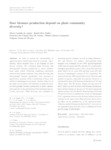Please use this identifier to cite or link to this item:
http://www.alice.cnptia.embrapa.br/alice/handle/doc/950111| Title: | Does biomass production depend on plant community diversity? |
| Authors: | AGUIAR, M. I. de  FIALHO, J. S.   ARAÚJO, F. das C. S. de   CAMPANHA, M. M.   OLIVEIRA, T. S. de   |
| Affiliation: | MONICA MATOSO CAMPANHA, CNPMS. |
| Date Issued: | 2013 |
| Citation: | Agroforestry Systems, Dordrecht, v. 87, n. 3, p. 699-711, 2013. |
| Description: | In order to ensure the sustainability of agroecosystems, biodiversity must be a priority. Agroforestry, which includes trees, is an example of such diverse systems. We evaluated plant diversity and aboveground biomass production to assess whether areas under fallow following traditional cultivation return to their initial condition. Also, plant diversity and aboveground biomass production were assessed in agroforestry systems (AFS) to determine if these were similar to unmanaged ecosystems. Another objective of the study was to observe the influence of plant diversity on aboveground biomass production in plant communities and also in the population of the dominant species, Cordia oncocalyx. Plant diversity was evaluated by assessing species richness, as well as using Shannon’s (H0) and Pielou’s (J0) indices. Aboveground plant biomass was evaluated in two AFS: agrosilvopastoral (ASP) and silvopastoral (SP), and also in a traditionally managed agricultural system (AG), areas that had been under fallow for six years (F6) and nine years (F9) and an area of unmanaged caatinga (CAT) vegetation. We observed that the ASP system had a lower diversity and number of species, especially tree species. However, it sustained the same total biomass production as CAT and fallow areas. The SP system, despite having lower H0 and J0 indices as well as lower total biomass production, had a similar number of species to CAT and cropped and fallow systems AG, F6 and F9. Plant biomass in F6 and F9 had recovered to productivity levels of unmanaged CAT vegetation; however the diversity indices were not restored to the same level. Plant diversity did not have an effect on the productivity of the agroecosystems. Likewise, annual biomass production by C. oncocalyx is not dependent upon diversity, but it is influenced by the growth stage of individuals. |
| Thesagro: | Ecologia vegetal |
| Keywords: | Agroecologia |
| DOI: | 10.1007/s10457-012-9590-9 |
| Type of Material: | Artigo de periódico |
| Access: | openAccess |
| Appears in Collections: | Artigo em periódico indexado (CNPMS)  |
Files in This Item:
| File | Description | Size | Format | |
|---|---|---|---|---|
| Doesbiomass1.pdf | 862,74 kB | Adobe PDF |  View/Open |









